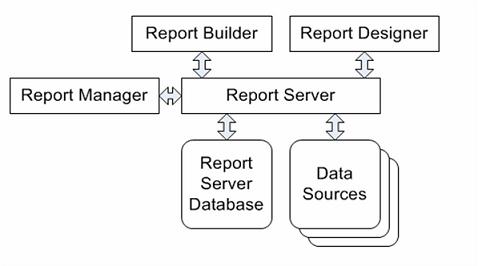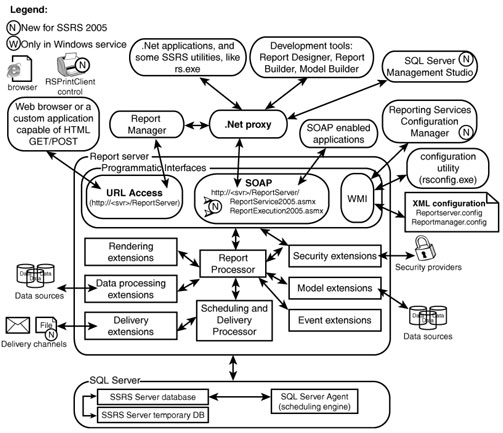| Programmatic interfaces | Provides access to SSRS functionality through SOAP and HTTP requests. |
| Report Processor | Facilitates a set of report generation operations from data retrieval to rendering. Report Processor invokes other components, such as data extensions to assist with report generation. |
| Data-processing extensions | Retrieves report's data from a data source. Developers can develop additional custom data-processing extensions. |
| Command-line utilities | Three utilities, designed to assist with scripting of administrative tasks, installed automatically during the Reporting Services install. |
| Rendering extensions | Transform the report's intermediate format (a combination of report's layout and data) into a device-specific format, such as HTML. Developers can create new rendering extensions. |
| Report Server database | Stores report definitions, report metadata, report history, cached reports, snapshots, resources, security settings, encrypted data, scheduling and delivery data, and more. |
| Report Server temporary database | Stores intermediate processing products, cache, and data. |
| Scheduling and Delivery Processor | Monitors for events (such as timed subscription), collaborates with Report Processor to render a report, and delivery extensions to deliver scheduled reports to a location specified in the subscription. |
| Delivery extensions | Deliver reports to specific devices, such as email or a file system. Developers can create new delivery extensions. |
| Report Manager | Provides web-based report access and management capabilities. Default URL that invokes Report Manager is http://<server>/reports. |
| Report Model Designer | Generates report models for use in Report Builder. |
| Report Builder | Provides drag-and-drop, easy-to-use report design functionality. Report Builder is an ad hoc end-user report authoring and publishing tool executed on a client computer. |
| Report Designer | Allows developers to develop complex reports. Report Designer is a comprehensive report authoring and publishing tool, hosted in Business Intelligence Development Studio or Visual Studio. |
| Security extensions | Enable authentication and authorization of users and groups. Developers can (excluding SQL Server Express edition) create new security extensions. |
| SQL Server Management Studio | Provides administrators with Windows form-based, integrated environment to manage SQL Server components including SSRS. From the report management perspective, Management Studio has similar functionality to Report Manager, but provides additional capabilities, such as consolidated web-farm management. |
| Reporting Services Configuration Tool | Provide administrators with functionality to start and stop Report Server Windows service and reconfigure report servers. This is a Windows forms application. |
| WMI provider | Provides a set of WMI interfaces to manage settings of a Report Server and assists with SSRS instance discovery on a network. |
| Performance monitoring objects | Provide a view of SSRS Windows and web service performance. |

